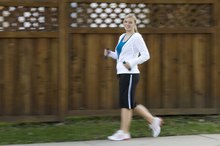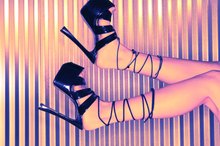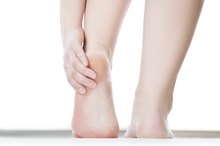How to Get Relief From Foot Pain Caused by Standing 10 Hours per Day
Every day, your feet have a big job to do. Whether you walk, run, or dance, they support your entire body and your movements. So standing for several hours a day puts strain on your legs and feet, and can lead to health complications including foot pain.
In addition, prolonged standing can aggravate pain caused by corn, callouses or foot deformities. If you suffer from foot pain due to overuse, try the following measures to manage and prevent this discomfort.
Get Relief at Work
Get relief from foot pain by making changes to your work environment, and by adjusting your body mechanics while at work. Wearing shoe inserts or compression stockings can help, and so can standing on anti-fatigue floor mats instead of hard, concrete floors.
One research review determined that changing positions frequently may be the most effective way to reduce complications from prolonged standing. Take the opportunity to walk around instead of standing still, and change from standing to sitting positions as much as able. Also, use a foot rest bar or stool to shift your body weight from one side to the other, and use your allowed breaks to rest and stretch.
Choose the Right Shoes
Shin Stretches for Runners
Learn More
Wear shoes that fit well. Take the opportunity to get properly fitted for work shoes, but it's best to do this after work to ensure they fit even if you have minor swelling. The shoes should have good arch and heel support, and conform to the shape of your feet.
Your toes should be able to wiggle some, and your heel shouldn't slide up and down as you walk. Purchase shoes that are adjustable — for example those that have laces — to personalize the fit if you have swelling or if your feet are slightly different sizes. If you struggle to find shoes that fit or don't cause pain, see a podiatrist to determine if you need custom insoles or footwear.
Stretch for Relief
Stretching can also provide relief. Below are some ways counter the effects of prolonged standing:
- While seated, and preferably with your shoes off, place one foot over the opposite knee. Holding your foot by your toes, slowly pull it towards you and hold for 10 seconds. Release, then repeat 20 times. Do the same stretch on your other foot.
- Roll a frozen water bottle under your feet, using moderate pressure, for 15 to 20 minutes.
- Roll a tennis ball under your feet, for 10 minutes on each side.
- If you have ongoing foot pain, your doctor or podiatrist can provide you with a personalized stretching program, and refer you to a physical therapist for assessment and care.
Get Relief at Home
Top of Foot Hurts When Walking
Learn More
In addition to stretching exercises, which can be done at work and at home, take the opportunity to rest your feet while at home. Elevate your feet to help reduce swelling, and place ice packs on the bottoms of your feet if this eases your discomfort.
Also, ask your doctor about self care for your feet. For example, your doctor may recommend you avoid high-impact exercise, such as running, and find exercises that do not aggravate your foot pain. Your doctor may also suggest over-the-counter nonsteroidal anti-inflammatory drugs, such as naproxen or ibuprofen, to diminish pain and inflammation in the feet.
Reviewed by Kay Peck, MPH RD
Tips
If you have ongoing foot pain, talk to your doctor or podiatrist about insoles for your shoes, which can be custom made or purchased based on shoe size. These are designed to absorb shock, support the feet and provide arch support, which can minimize foot pain.
Also, if your foot pain is due to your job, speak with your manager about ways to reduce your risk of health problems due to prolonged standing.
Warnings
Prolonged standing can cause ligaments and tendons to get irritated and inflamed, which can lead to plantar fasciitis, affecting the band of tissue that supports your foot arch, or Achilles tendinitis, which impacts the large tendon that runs down the back of your lower leg.
In addition, poor fitting shoes can create pain due to hammertoes or bunions, and can contribute to the development of corns and callouses. If you have foot pain that is not resolved by home treatment, see your doctor or ask for a referral to a podiatrist.
Related Articles
References
- American Academy of Orthopaedic Surgeons: Plantar Fasciitis and Bone Spurs
- American Academy of Orthopaedic Surgeons: Achilles Tendinitis
- The Official Journal of the Association of Rehabilitation Nurses: Evidence of Health Risks Associated with Prolonged Standing at Work and Intervention Effectiveness
- Occupational Health and Safety: Improved Ergonomics for Standing Work
- American Orthopaedic Foot & Ankle Society. Metatarsalgia (Forefoot Pain). http://www.aofas.org/footcaremd/conditions/ailments-of-the-smaller-toes/Pages/Metatarsalgia.aspx.
- Mayo Clinic. Foot pain. http://www.mayoclinic.org/symptoms/foot-pain/basics/definition/SYM-20050792.
- Allam AE, Chang KV. Plantar Heel Pain. StatPearls Publishing. Updated May 18, 2019.
- Buldt AK, Menz HB. Incorrectly fitted footwear, foot pain and foot disorders: a systematic search and narrative review of the literature. J Foot Ankle Res. 2018;11:43. doi:10.1186/s13047-018-0284-z
- Shim JM. The effects of wet heat and dry heat on the gait and feet of healthy adults. J Phys Ther Sci. 2014;26(2):183-5. doi:10.1589/jpts.26.183
- Sweeting D, Parish B, Hooper L, Chester R. The effectiveness of manual stretching in the treatment of plantar heel pain: a systematic review. J Foot Ankle Res. 2011;4:19. doi:10.1186/1757-1146-4-19
- Kim EK, Kim JS. The effects of short foot exercises and arch support insoles on improvement in the medial longitudinal arch and dynamic balance of flexible flatfoot patients. J Phys Ther Sci. 2016;28(11):3136-3139. doi:10.1589/jpts.28.3136
- Lee J, Han M, Chung Y, Kim J, Choi J. Effects of foot reflexology on fatigue, sleep and pain: a systematic review and meta-analysis. J Korean Acad Nurs. 2011;41(6):821-33. doi:10.4040/jkan.2011.41.6.821
- Silfverskiöld JP. Common foot problems. Relieving the pain of bunions, keratoses, corns, and calluses. Postgrad Med. 1991;89(5):183-8. doi:10.1080/00325481.1991.11700901
- Chen W, Yang GY, Liu B, Manheimer E, Liu JP. Manual acupuncture for treatment of diabetic peripheral neuropathy: a systematic review of randomized controlled trials. PLoS One. 2013;8(9):e73764. doi:10.1371/journal.pone.0073764
- Mishra SC, Chhatbar KC, Kashikar A, Mehndiratta A. Diabetic foot. BMJ. 2017;359:j5064. doi:10.1136/bmj.j5064
- David clark J, Tawfik VL, Tajerian M, Kingery WS. Autoinflammatory and autoimmune contributions to complex regional pain syndrome. Mol Pain. 2018;14:1744806918799127. doi:10.1177/1744806918799127
- Hill CL, Gill TK, Menz HB, Taylor AW. Prevalence and correlates of foot pain in a population-based study: the North West Adelaide health study. J Foot Ankle Res. 2008;1(1):2. doi:10.1186/1757-1146-1-2
- Chen W, Yang GY, Liu B, Manheimer E, Liu JP. Manual acupuncture for treatment of diabetic peripheral neuropathy: a systematic review of randomized controlled trials. PLoS One. 2013 Sep 12;8(9):e73764.
- Tillu, A. Effect of acupuncture treatment on heel pain due to plantar fasciitis. Acupuncture in Medicine 1998;16:66-68.
- American Orthopaedic Foot & Ankle Society. Metatarsalgia (Forefoot Pain).
- Mayo Clinic. Foot pain.
Resources
Writer Bio
Eric Mohrman has been a freelance writer since 2007, focusing on travel, food and lifestyle stories. His creative writing is also widely published. He lives in Orlando, Florida.









